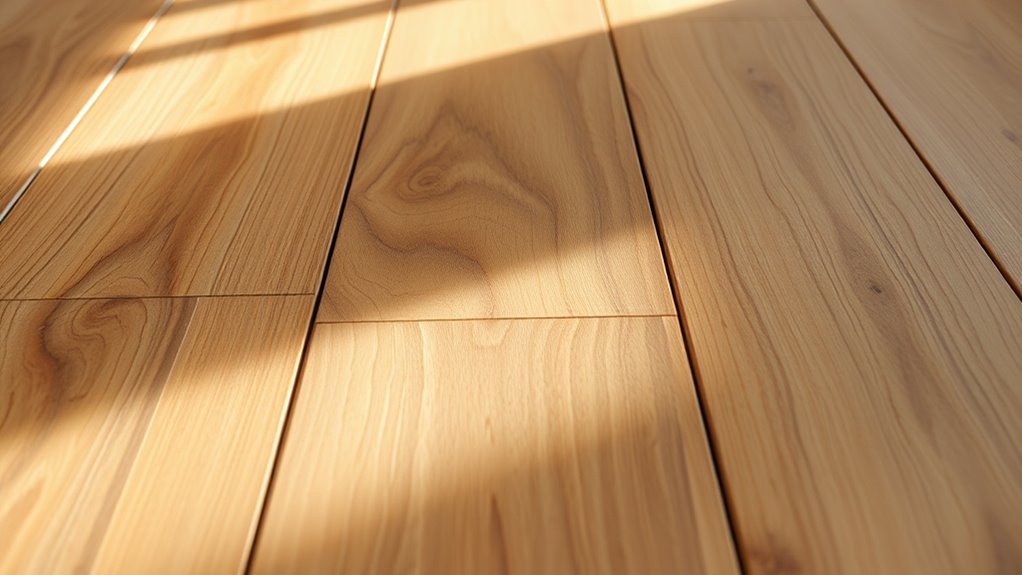Choosing sustainable flooring with wide planks and eco-friendly finishes allows you to create a stylish, environmentally responsible space. Wide planks reduce waste by requiring fewer joints and highlight natural textures for a seamless look. Eco-friendly dyes and finishes made from non-toxic, plant-based ingredients improve indoor air quality and support responsible manufacturing. Reclaimed wood adds character while conserving resources and reducing waste. Keep exploring to discover how these sustainable choices can transform your home into an eco-conscious masterpiece.
Key Takeaways
- Wide planks reduce material waste and create a natural, seamless aesthetic, supporting sustainability and timeless design.
- Eco friendly dyes made from non-toxic, plant-based ingredients improve indoor air quality and minimize chemical impact.
- Reclaimed wood repurposes existing materials, conserving trees and adding character while reducing environmental footprint.
- Combining reclaimed wood with eco friendly finishes enhances durability, authenticity, and sustainability of flooring installations.
- Sustainable flooring choices promote responsible manufacturing practices and eco-conscious consumer preferences.

Have you ever considered how the choice of flooring can impact the environment? When you select sustainable flooring options, you’re making a conscious decision to reduce your ecological footprint. Wide planks are an excellent choice because they use fewer joints, which means less waste during installation and a more natural, seamless look. To make your flooring even more eco-friendly, you can look for products finished with eco friendly dyes. These dyes are made from non-toxic, plant-based ingredients, avoiding harmful chemicals that can leach into the environment or affect indoor air quality. Choosing finishes with eco friendly dyes not only minimizes your home’s chemical exposure but also supports environmentally responsible manufacturing practices.
In addition to eco friendly dyes, reclaimed wood techniques play a vital role in sustainable flooring. Instead of harvesting new timber, reclaimed wood involves repurposing wood from old buildings, barns, or other structures. This approach conserves trees, reduces deforestation, and prevents the waste of usable materials. When you opt for reclaimed wide planks, you’re giving new life to aged wood, which often boasts unique character and rich textures that new wood simply can’t match. Reclaimed wood techniques also tend to be more environmentally conscious because they involve fewer chemical treatments and less energy consumption than producing new wood flooring.
Using reclaimed wood and eco friendly dyes together creates a flooring solution that’s both beautiful and responsible. The natural imperfections and aged patina of reclaimed wood add depth and authenticity to your space, while eco friendly dyes ensure that the finish remains safe for your family and the planet. Wide planks made from reclaimed wood look striking and timeless, emphasizing sustainability without sacrificing style. These materials often come with a story, giving your home a sense of history and character that mass-produced flooring can’t replicate.
Moreover, when you choose sustainable flooring with reclaimed wood techniques and eco friendly dyes, you’re supporting responsible forestry and manufacturing practices. This choice reduces the demand for virgin materials and harmful chemicals, contributing to a healthier planet. It also encourages manufacturers to adopt greener practices, such as using renewable energy sources or recycling waste materials. As a homeowner, your conscious decision to prioritize eco friendly dyes and reclaimed wood techniques helps foster a more sustainable industry.
Frequently Asked Questions
How Do Wide Planks Impact Indoor Air Quality?
Wide planks can improve your indoor air quality because they often emit fewer VOCs compared to narrower, glued-together boards. They’re also easier to clean, reducing indoor allergens like dust and pet dander that can settle between seams. When choosing wide planks, opt for low-VOC finishes to minimize emissions further. This way, you create a healthier environment while enjoying the aesthetic benefits of wide flooring planks.
Are Natural Finishes More Durable Than Synthetic Ones?
Is durability a dance of time and material? Natural finishes often outlast synthetic ones when you choose eco-friendly sealants and VOC-free finishes, which protect without harsh chemicals. They resist wear better and age gracefully, adding character to your space. While synthetics may seem easier to apply, natural options embrace the environment and your home’s longevity, proving that true durability comes from harmony with nature rather than synthetic shortcuts.
What Maintenance Is Required for Sustainable Flooring?
You should regularly clean your sustainable flooring with a damp mop and use eco-friendly adhesives for repairs. Avoid harsh chemicals, and opt for sustainable cleaning products to maintain its eco integrity. Protect the surface from scratches by using furniture pads and avoid excessive moisture. Routine upkeep keeps your flooring durable and beautiful, ensuring it remains environmentally friendly and resilient for years to come.
Can Sustainable Flooring Be Installed Over Existing Floors?
Yes, you can install sustainable flooring over existing floors. To do this, make certain the surface is level and clean. Use eco-friendly adhesives to secure the new flooring, and consider reclaimed wood options for added sustainability. This approach minimizes waste and reduces environmental impact. Just be sure to follow manufacturer guidelines and, if needed, consult a professional to ensure proper installation for long-lasting, eco-conscious results.
How Do Finishes Affect the Longevity of Wide Plank Flooring?
Finishes substantially impact the longevity of your wide plank flooring. Studies show that properly applied, durable finishes can extend a floor’s lifespan by up to 30%. Using eco-friendly sealants and VOC-free coatings helps preserve the wood while maintaining indoor air quality. These finishes protect against moisture, scratches, and wear, ensuring your flooring stays beautiful longer and aligns with sustainable living goals. Proper finishing is key to maximizing your floor’s durability.
Conclusion
Choosing sustainable flooring with wide planks and eco-friendly finishes gently guides your space toward a more harmonious future. By making mindful choices, you subtly support environmental well-being while enhancing your home’s beauty. Every step you take toward greener options whispers a quiet promise to the planet, blending style with responsibility. Embrace these mindful decisions, and you’ll create a welcoming environment that quietly reflects your care for the world around you.









